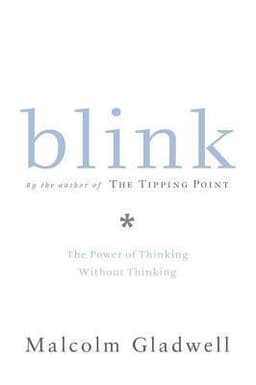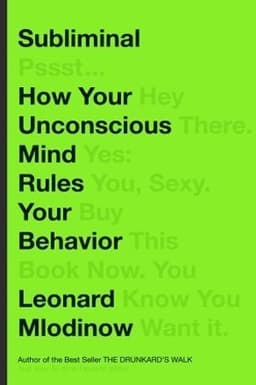
Blink Book Summary
The Power of Thinking Without Thinking
Book by Malcolm Gladwell
Feeling Lazy?Read 1 Minute Summary
Summary
"Blink" unveils the hidden power of our rapid, unconscious judgments, revealing how these split-second decisions can be remarkably insightful or dangerously flawed, and offers strategies to harness this 'thinking without thinking' for better decision-making in our personal and professional lives.
Sign in to rate
Average Rating: 4.67
The Power of Thin-Slicing
Malcolm Gladwell introduces the concept of "thin-slicing" - the ability to make quick judgments based on limited information. He argues that these rapid cognitions can often be as accurate or more accurate than careful, deliberate decision-making. Gladwell provides several compelling examples:
- Art experts instantly recognizing a fake Greek statue at the Getty Museum
- Psychologist John Gottman predicting divorce with 95% accuracy after watching just an hour of a couple's interaction
- Tennis coach Vic Braden instinctively knowing when a player will double-fault
Section: 1, Chapter: 1
The Adaptive Unconscious: Our Internal Computer
Gladwell introduces the concept of the "adaptive unconscious," describing it as a kind of giant computer that quickly and quietly processes a lot of the data we need in our everyday lives. Unlike the Freudian unconscious, which is a dark, murky place of desires and memories, the adaptive unconscious is a helpful tool that allows us to navigate complex situations rapidly. Key points:
- It makes rapid judgments based on very little information
- It operates entirely below the surface of consciousness
- It's critical for survival and daily functioning
- It can be more effective than conscious deliberation in certain situations
Section: 1, Chapter: 1
The Perils of Too Much Information
Gladwell presents the intriguing case of Cook County Hospital's approach to diagnosing heart attacks. The hospital adopted a simple algorithm developed by cardiologist Lee Goldman, which used just four factors to determine if a patient was having a heart attack. This method proved more accurate than the traditional approach of considering a wide range of factors and conducting numerous tests.
This example illustrates a counterintuitive principle: sometimes, less information leads to better decisions. By focusing on just a few key indicators, doctors were able to make faster and more accurate diagnoses. Gladwell argues that this principle applies beyond medicine - in many situations, an excess of information can cloud our judgment and lead to poorer decisions.
Section: 1, Chapter: 1
"The Face Is Like The Penis!"
"Silvan Tomkins once began a lecture by bellowing, 'The face is like the penis!' What he meant was that the face has, to a large extent, a mind of its own."
This provocative quote introduces Gladwell's discussion of how our faces often betray our true feelings, even when we're trying to hide them. He explains that our facial expressions are controlled by both voluntary and involuntary systems, and that the involuntary system often reveals our genuine emotions. This insight is crucial for understanding how we communicate non-verbally and how others can read our true feelings.
Section: 1, Chapter: 2
The Danger of Explaining Our Instincts
Gladwell warns about the dangers of trying to explain or rationalize our instinctive decisions. He cites several studies showing that when people are forced to explain their choices, they often make worse decisions or become less consistent in their preferences. This is because many of our instinctive judgments come from our adaptive unconscious, which operates outside our awareness and can't always be easily articulated.
- Trust your instincts, especially in areas where you have expertise
- Be wary of overanalyzing decisions that are best made quickly
- Recognize that you may not always be able to explain why you feel a certain way about something
- In some situations, going with your gut feeling may lead to better outcomes than extensive deliberation
Section: 1, Chapter: 2
The Power and Peril of Priming
Gladwell explores the concept of "priming" - how subtle cues in our environment can unconsciously influence our behavior and decisions. He describes several fascinating experiments:
- People who unscrambled sentences with words related to the elderly walked more slowly afterwards
- Students primed with words related to intelligence performed better on trivia tests
- African American students who were reminded of their race before a test performed worse due to stereotype threat
Section: 1, Chapter: 2
Listening to Your Body
Gladwell discusses how our bodies often react to situations before our conscious minds do. He cites the Iowa Gambling Task experiment, where participants' palms began to sweat when they drew from disadvantageous decks of cards, long before they consciously realized which decks were "bad."
Pay attention to physical reactions like increased heart rate, sweating, or gut feelings. These bodily signals may provide valuable information before you consciously understand a situation. Your body's reactions may guide you to the right decision faster than deliberate thinking. Practice mindfulness to become more aware of these subtle physical cues
Section: 1, Chapter: 2
The Warren Harding Error: The Dark Side of Thin-Slicing
Gladwell introduces the concept of the "Warren Harding Error," named after the U.S. president who was elected largely based on his appearance rather than his qualifications. This chapter explores how our rapid judgments can sometimes lead us astray, particularly when we allow superficial traits to override more relevant information.
Warren Harding was elected president largely because he "looked presidential". Physical appearance, height, and other irrelevant factors often play a disproportionate role in how we judge others. These snap judgments can have serious consequences in areas like hiring, promotions, and elections
Section: 1, Chapter: 3
The Implicit Association Test: Unveiling Hidden Biases
Gladwell introduces the Implicit Association Test (IAT), a tool developed by psychologists to measure unconscious biases. The IAT reveals how deeply ingrained certain associations are in our minds, often contradicting our consciously held beliefs.
How the IAT works:
- Participants rapidly categorize words or images
- The speed of categorization reveals underlying associations
- Many people show bias even when they consciously reject prejudice
Gladwell takes the Race IAT himself and discovers his own unconscious biases, demonstrating how pervasive these hidden associations can be.
Section: 1, Chapter: 3
"Height, Hair, and Horsepower"
"Most of us, in ways that we are not entirely aware of, automatically associate leadership ability with imposing physical stature."
Gladwell uses this quote to introduce his discussion of how physical attributes, particularly height, influence our perceptions of others. He cites research showing that a disproportionate number of CEOs are tall, and that height correlates with salary even when controlling for other factors. This demonstrates how our unconscious biases can have real-world impacts on people's careers and lives.
Section: 1, Chapter: 3
Overcoming Bias in Car Sales
Gladwell presents the case of Bob Golomb, a highly successful car salesman who attributes his success to treating all customers equally, regardless of their appearance. This approach contrasts sharply with the industry norm, where salespeople often make snap judgments about customers' buying potential based on race, gender, or dress.
Golomb's approach:
- Assumes every customer has an equal chance of buying
- Avoids prejudging based on appearance
- Focuses on understanding each customer's needs
Section: 1, Chapter: 3
The Power of Structured Spontaneity
In Chapter 4, Gladwell explores how structure and rules can paradoxically enhance spontaneity and quick decision-making. He uses the example of improvisational comedy and military strategy to illustrate this point.
- Improvisation relies on a set of underlying rules that guide spontaneous creation
- These rules provide a framework that allows for quick, creative responses
- Similar principles apply in other high-pressure, fast-paced environments like emergency rooms and battlefields
Section: 1, Chapter: 4
The Perils of Over-Analysis: Millennium Challenge '02
Gladwell recounts the story of Millennium Challenge '02, a massive military war game conducted by the U.S. military. The exercise pitted a high-tech Blue Team (representing the U.S.) against a low-tech Red Team led by retired Marine Corps general Paul Van Riper.
Despite Blue Team's technological superiority and extensive planning, Van Riper's Red Team managed to outmaneuver them by using unconventional tactics and quick, adaptive decision-making. Van Riper's approach:
- Relied on decentralized command structure
- Encouraged rapid, intuitive decision-making
- Avoided over-analysis and information overload
Section: 1, Chapter: 4
The Danger of Information Overload
Gladwell draws important lessons from the Millennium Challenge '02 exercise about the dangers of information overload and over-analysis. He argues that in many situations, having more information doesn't necessarily lead to better decisions.
- Recognize when you have enough information to make a decision
- Avoid analysis paralysis by setting time limits on deliberation
- Trust in expertise and intuition, especially in time-sensitive situations
- Create systems that filter information to focus on what's most important
- Practice making decisions with limited information to improve your rapid cognition skills
Section: 1, Chapter: 4
You Don't Need to Know Everything
"What the cognitively busy, logically trained Blue Team commanders saw as a complex and difficult problem, the Red Team commanders saw as something so simple that it could be solved with a single leap of intuition."
This quote encapsulates a key theme of the chapter: sometimes, simplicity and intuition can triumph over complexity and extensive analysis. Gladwell uses this to argue that effective decision-making often involves knowing what information to ignore, rather than trying to process everything available.
Section: 1, Chapter: 4
The Perils of Market Research: Kenna's Dilemma
Gladwell introduces the story of Kenna, a talented musician whose unique sound was loved by music industry insiders but repeatedly rejected by focus groups and market research.
Kenna's music was highly praised by industry experts and fellow musicians, but his songs consistently performed poorly in market research tests. This mismatch highlights the difficulty of predicting long-term preferences from short-term exposure
Gladwell argues that snap judgments by experts can sometimes be more accurate than extensive market research. This example also challenges the common belief that more data always leads to better decisions, especially in creative fields.
Section: 1, Chapter: 5
The Pepsi Challenge: Sips vs. Cans
Gladwell revisits the famous "Pepsi Challenge" to illustrate how the conditions of taste tests can lead to misleading results. He explains that while Pepsi often wins in sip tests, Coca-Cola remains the market leader.
Sip tests favor sweeter, more intense flavors (like Pepsi), but these preferences don't necessarily translate to whole-can consumption. This discrepancy led Coca-Cola to the disastrous launch of New Coke in 1985. The incident demonstrates how snap judgments (sip tests) can sometimes mislead us about our true preferences.
Section: 1, Chapter: 5
The Power of Sensation Transference
Gladwell introduces the concept of "sensation transference," developed by marketing expert Louis Cheskin. This principle states that people unconsciously transfer sensations or impressions from the packaging of a product to the product itself.
Examples of sensation transference:
- Changing margarine's color to yellow made it taste more like butter to consumers
- The weight and sound of a car door closing influences perceptions of the car's quality
- The packaging of a product can significantly affect taste perceptions
Section: 1, Chapter: 5
"The Mind Knows Not What The Tongue Tastes"
"The mind knows not what the tongue tastes. A food's objective taste does not necessarily predict its liking. The disconnect between sensation and perception is the root of many product failures, and a source of ongoing frustration to companies across a wide variety of industries."
Section: 1, Chapter: 5
The Delicate Art of Mind Reading
In Chapter 6, Gladwell explores the concept of "mind-reading" - our ability to quickly infer others' thoughts and emotions from subtle cues. He focuses on how this skill can sometimes fail, leading to tragic consequences.
Humans are generally very good at reading others' emotions and intentions: This ability relies on rapid, unconscious processing of facial expressions and body language. However, stress, time pressure, and preconceived notions can impair this ability.
Section: 1, Chapter: 6
The Tragedy of Amadou Diallo
Gladwell examines the shooting of Amadou Diallo, an unarmed Black man killed by New York City police officers in 1999. He uses this tragic incident to illustrate how mind-reading can fail under stress and time pressure.
The officers misinterpreted Diallo's actions as threatening, as stress and preconceived notions led to a cascading series of misjudgments. This case highlights the importance of creating conditions that allow for accurate mind-reading in high-stakes situations.
Section: 1, Chapter: 6
The Perils of Temporary Autism
Gladwell introduces the concept of "temporary autism" to describe situations where our normal mind-reading abilities break down. He explains that under extreme stress or time pressure, people can become temporarily unable to accurately interpret others' emotions and intentions.
Characteristics of temporary autism:
- Tunnel vision and reduced peripheral awareness
- Difficulty processing emotional cues
- Tendency to misinterpret ambiguous actions as threatening
- Impaired ability to consider alternative explanations for behavior
Section: 1, Chapter: 6
The Importance of Creating "Behavioral Outs"
Gladwell discusses strategies for preventing mind-reading failures in high-stakes situations, focusing on the concept of "behavioral outs" - tactics that create space and time for more accurate assessment of a situation.
- In potentially confrontational situations, slow down the pace of interactions
- Create physical distance to reduce perceived threat and allow for better observation
- Use verbal techniques to buy time and gather more information
- Train for high-stress scenarios to improve performance under pressure
- Develop protocols that force a pause before escalating to the use of force
Section: 1, Chapter: 6
Related Content


Subliminal Book Summary
Leonard Mlodinow
Subliminal: How Your Unconscious Mind Rules Your Behavior reveals the powerful influence of the unconscious mind on our thoughts, feelings, and actions - from how we perceive the world, to how we interact with others, make decisions, and understand ourselves.
Subliminal: How Your Unconscious Mind Rules Your Behavior reveals the powerful influence of the unconscious mind on our thoughts, feelings, and actions - from how we perceive the world, to how we interact with others, make decisions, and understand ourselves.
Psychology
Neuroscience
Business


What Every Body is Saying Book Summary
Joe Navarro
"What Every Body is Saying" unlocks the secrets of nonverbal communication, teaching you to decode the hidden messages in every gesture, expression, and movement, so you can interact with confidence, detect deceit, and build stronger relationships in all areas of life.
"What Every Body is Saying" unlocks the secrets of nonverbal communication, teaching you to decode the hidden messages in every gesture, expression, and movement, so you can interact with confidence, detect deceit, and build stronger relationships in all areas of life.
Psychology
Communication
Personal Development
Human Behavior

